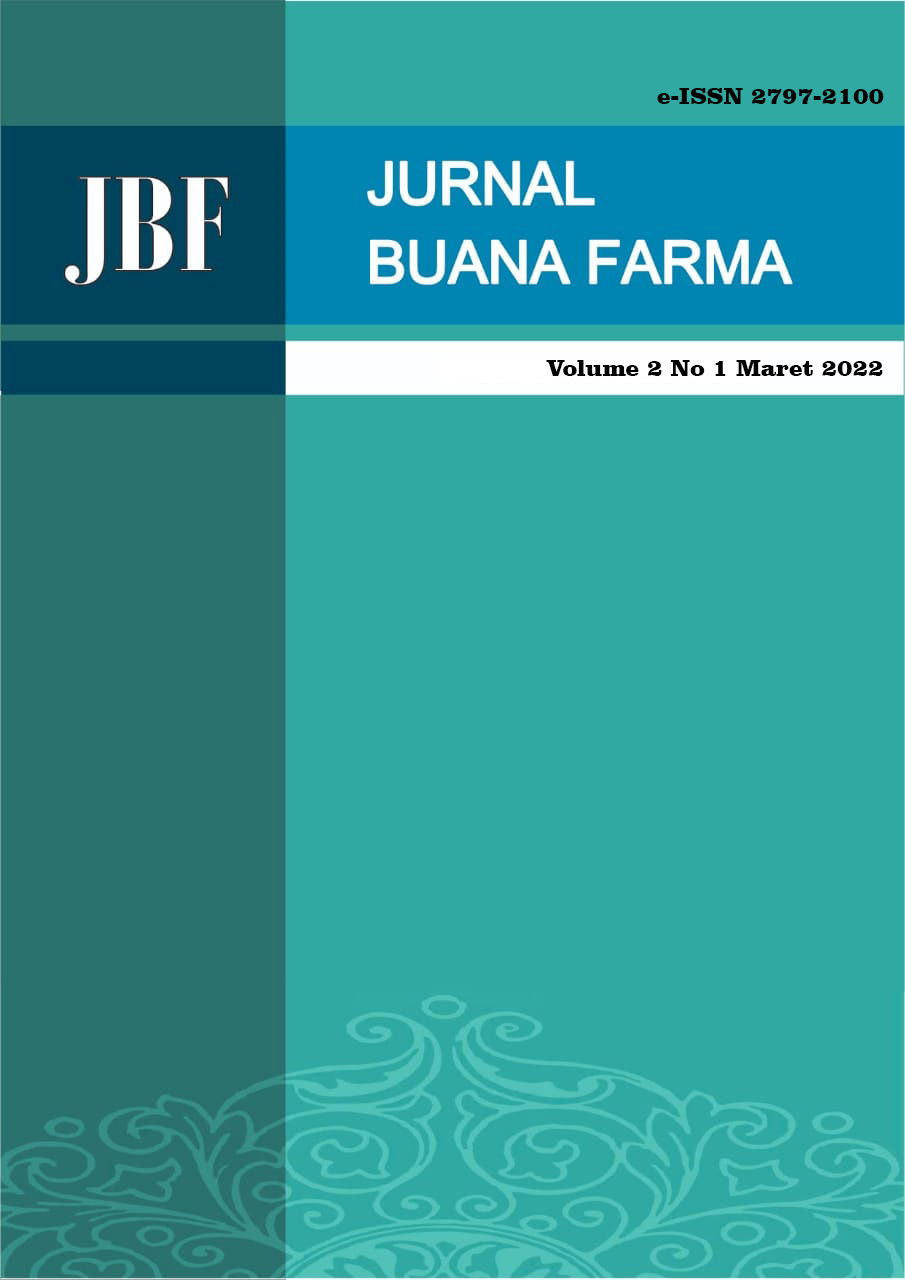EVALUASI PENGGUNAAN OBAT ANTIBIOTIK PADA PASIEN BALITA YANG TERDIAGNOSA DIARE DI KLINIK ISYKARIMA CIKARANG
Abstract
Due to the increasing number of people experiencing diarrhea every year, it has long been considered one of the most severe public health problems in the world. As a result, diarrhea is a significant cause of death in children under 5 years of age. The Ministry of Health of the Republic of Indonesia conducted an incident survey, which revealed that 1,637,708 diarrhea patients were treated in health care institutions, or 40.90 percent of the projected number of diarrhea patients. This study aims to determine whether antibiotics are effective in treating diarrhea in children under five at Isykarima Clinic Cikarang when used according to patient characteristics, indications, drug selection, and the right dose. This descriptive study used a cross sectional technique. This study used a descriptive observational research approach, in which prescriptions and test results from medical records (MR) were collected and recorded. By using retrospective data collection method. According to the research that has been done, it can be concluded that the male gender who suffers from diarrhea is 44 toddlers (55%). The rationale for the use of diarrhea drugs in patients under five according to the criteria for the right indication (100%), the right dose (100%), the right patient (100%), and the right drug (100%). The clinic has used antibiotics as indicated. According to usage, the most widely used antibiotic is cotrimoxazole.
References
BPOM RI, 2008, Informatorium Obat Nasional Indonesia, Sagung seto, Jakarta.
Canani,R.B., Cirillo, P., Cesarano, L., Spagnulo, M.I., Vincenzo, A.D., Albano, F., et. al., 2007, Probiotics for treatment of acute diarrhoea in children: randomised clinical trial of five different preparations, Italy, BMJ.
Dipiro, JT., Robert, LT., Gary, CY., Gary RM., Barbara, GW., & Michael, PL., 2008, Pharmacotherapy A PathophysiologicApproach seventh edition, McGraw Hill Medical:USA, 617-623.
Depkes RI, 2008, Materi Pelatihan Peningkatan Pengetahuan dan Keterampilan Memilih Obat bagi Tenaga Kesehatan, Jakarta, Departemen Kesehatan Republik Indonesia.
Elmaghraby, N. A., Khames, A., Meabed, M. H. & Elmaraghy, M. A., 2014,Comparison the Antipyretic Effect of Paracetamol, Metamizole Sodium and Diclofenac Potassium in Breaking down Fever in Children, Amerika, vol 10.
Fatimah.N., 2011, Evaluasi Pengobatan Diare Akut pada Pasien Rawat Inap RSUD DR. Moewardi Surakarta 2009, Skripsi, Fakultas Farmasi, Universitas Muhammadiyah Surakarta
Fentami, N. A. (n.d.). Gambaran Penggunaan Obat Diare Pada Pasien Balita Di Rsup Persahabatan.
Gould, I. M. (2008). The epidemiology of antibiotik resistance. International Journal of Antimicrobial Agents, 32(SUPPL. 1), 2–9. https://doi.org/10.1016/j.ijantimicag.2008.06.016
Guarino A, Ashkenazi S, Gendrel D, Lo Vecchio A, Shamir R, Szajewska H; European Society for Pediatric Gastroenterology, Hepatology, and Nutrition; European Society for Pediatric Infectious Diseases. European Society for Pediatric Gastroenterology, Hepatology, and Nutrition/ European Society for Pediatric Infectious Diseases evidence-based guidelines for the management of acute gastroenteritis in children in Europe: Update 2014. J Pediatr Gastroenterol Nutr. 2014;59(1):132 –52. doi: 10.1097/MPG.00000000000003 75
Jas, A., (2007). Perihal Resep dan Dosis Serta Latihan Menulis Resep. Ed. 1. Medan : Universitas Sumatera Utara Press.
Juffrie, M., Soenarto, S. S.Y., Oswari, H., Arief, S., Rosalinal., Mulyani, N.S. (2015). Buku Ajar Gastroenterologi Anak Indo-Hepatologi. Jakarta: Badan Penerbit Ikatan Dokter Anak Indonesia. Jilid 1.
Kementrian Kesehatan Republik Indonesia. (2012). Profil Kesehatan Indonesia Tahun 2011. In Kementrian Kesehatan Republik Indonesia.
Lestari. K.S, R. O. (2009). Resep Obat. 193.
Liu L, Johnson HL, Cousens S, Perin J, Scott S, Lawn JE, et al. Global, regional, and national causes of child mortality: an updated systematic analysis for 2010 with time trends since 2000. Lancet. 2012; 379(9832):2151–61. doi: 10.1016/S0140 -6736(12)60560-1.
Megawati, A., & Sari, D. F. (2018). Rasionalitas Penggunaan Antibiotik Untuk Pengobatan Diare Pada Pasien Anak Di Instalasi Rawat Inap Rsud Raa Soewondo Pati Tahun 2017. Cendekia Journal of Pharmacy, 2(1), 68–80. https://doi.org/10.31596/cjp.v2i1.19
Narindrani, R., Sunyoto, & Hana, C. (2011). Ketepatan Penggunaan Antibiotik pada Kasus Diare Akut di Sertai Infeksi Bakteri pada Anak Usia 1-6 Tahun Pasien Rawat Inap Di Rsi Klaten Tahun 2011. Journal Of Pharmacy Science.
Rachmawati, Y., Suharsono and Sutrisna, E. M. (2014) ‘Evaluasi Penggunaan Antibiotik Pada Pasien Gastroenteritis Di Instalasi Rawat Inap Rumah Sakit “X” Periode Januari-Juni 2013’.
Raini, M., Gitawati, R. and Rooslamiati, I. (2015) ‘Kerasionalan penggunaan obat diare yang disimpan di rumah tangga di Indonesia’, Jurnal Kefarmasian Indonesia, 5(1), pp. 49–56.
Schiller, L. R., Pardi, D. S., & Sellin, J. H. (2017). Chronic Diarrhea: Diagnosis and Management. Clinical Gastroenterology and Hepatology, 15(2), 182-193.e3. https://doi.org/10.1016/j.cgh.2016.07.028
Sitawati, C. (2016). Hubungan Persepsi Pendidikan. Universitas Muhammadiyah Purwokerto, 23–45.
Susanti, T., & Supriani. (2020). Evaluasi Penggunaan Antibiotik Pada Pasien Anak Dengan Diare. Jurnal Farmasetis, 8(1), 23–30.
Tambuwun, F., Ismanto, A. Y. and Silolonga, W. (2015) ‘Hubungan sanitasi lingkungan dengan kejadian diare pada anak usia sekolah di wilayah kerja puskesmas bahu manado’, e-journal keperawatan (e-Kp), 3.
Utami, W. S. N. and Yulianti, T. (2012) ‘Evaluasi Penggunaan Antibiotik Untuk Penyakit Diare Pada Pasien Pediatri Rawat Inap Di RSUD “X” Tahun 2011’.
Ward, C. I. (2017). Bangsal Rawat Inap Anak Antibiotiks Utilization Review Among Patients With Acute Diarrhoea in. 7, 15–23.
WHO. (2005). The Treatment of Diarrhoea: A Manual for Phycisians and Other Seniors Health Workers. Switherland:WHO. Hal. 4-15.
WHO. (2007). Promoting Safety Of Medicine For Children. Geneya: WHO Press. Hal. 12-13
Yuniati, R., Mita, N., & Ibrahim, A. (2016). Kajian Penggunaan Antibiotik Penderita Diare Pada Pasien Pediatrik Di Instalasi Rawat Inap Rsud Abdul Wahab Sjahranie Samarinda. April 2016, 109–121. https://doi.org/10.25026/mpc.v3i1.73Rodriguez-Roisin R. COPD exacerbation. 5: Management, Review Series. Thorax 2006: 6; h 535–44













